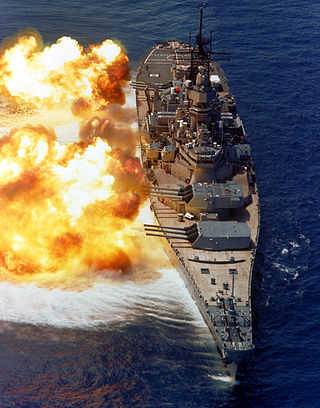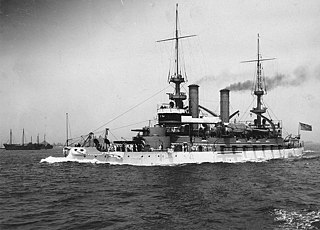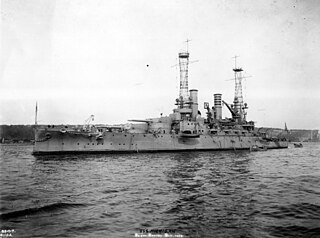Design
Single turreted monitors, these ships mounted the most modern heavy guns in the US Navy at the time they were built, 12-inch (305 mm)/40 caliber guns. The Arkansas-class monitors did not see any combat during World War I and instead served as submarine tenders. Alexander C. Brown, writing in the Society of Naval Architects and Marine Engineers Historical Transactions noted in a penetrating comment that:
Monitors found their final employment as submarine tenders in World War I for which their low freeboard hulls made them well suited. It is significant to note, however, that in this humble capacity they were ministering to the needs of that type of craft which had logically replaced them for as initially envisaged monitors were designed to combine heavy striking power with concealment and the presentation of a negligible target area
They had a displacement of 3,225 long tons (3,277 t ; 3,612 short tons ), measured 255 feet 1 inch (77.75 m ) in overall length, with a beam of 50 feet 1 inch (15.27 m) and a draft of 12 feet 6 inches (3.81 m). They were manned by a total crew of 13 officers and 209 men.
Arkansas' were powered by two vertical triple expansion engines driving two screw propellers with steam generated by four steam boilers. The engines in the Arkansas' were designed to produce 2,400 indicated horsepower (1,800 kW ) with a top speed of 12.5 knots (23.2 km/h ; 14.4 mph ), however, on sea trials only Nevada had top speed over 12.5 knots, 13.04 kn (24.15 km/h; 15.01 mph), the rest came in below. The Arkansas' was designed to provide a range of 2,360 nautical miles (4,370 km ; 2,720 mi ) at 10 kn (19 km/h; 12 mph).
The ships were armed with a main battery of two 12-inch/40 caliber guns, either Mark 3 or Mark 4, in a Mark 4 turret. The secondary battery consisted of four 4-inch (102 mm)/50 caliber Mark 7 guns along with three 6-pounder 57 mm (2.2 in) guns. The main belt armor was 11 in (280 mm) in the middle tapering to 5 in (130 mm) at the ends. The gun turrets were between 10 and 9 in (250 and 230 mm), with 11 to 9 in (280 to 230 mm) barbettes. The Arkansas' also had a 1.5 in (38 mm) deck.
Construction
In response to increasing public pressure regarding the state of the nation's coastal defense forces and hastened by the outbreak of war with Spain, the U.S. Congress passed the Naval Appropriations Act of 1898 on May 4, which, among many other things, authorized the appropriation of $5 million to build four new Monitors, each of which were to cost no more than $1,250,000. [5] The new ships, created for harbor defense, were designed by Chief constructor Philip Hichborn with the original plans calling for a length of 225 ft and a beam of 50 ft, with a displacement of 2700 tons, a coal capacity of 200 tons, and a side armor belt of 11-inch thickness. For armament, the ship was to be equipped with a main battery containing a single turret with two 12-inch guns (Hichborn balanced), and four rapid-fire breech-loading rifles, with a secondary battery consisting of three 6-pound and four 1-pound rifles. Powered by two vertical triple-expansion type engines and twin-screw propellers, the ship would have a maximum speed of 12 knots. [6]
Contractors
Bidding began for the construction of the new monitors on October 1, with the following results, including price: [7]
Following the bidding, the Navy announced the names of the ships. [8] [9]
Criticism and Proposed Redesign
The new Monitors were met with criticism by many, as their design and armament made them no greater than any of the older navy Monitors, such as the Monterey, Monadnock, and Terror. The main complaint was the single turret, rather than a two-turret design as seen on the USS Terror. [10] [11] [12] There were also those that argued that the entire building of four ships was a waste of money, as the monitors that participated in the Spanish-American War were met with considerable criticism, most chiefly from Rear Admiral William T. Sampson who criticized the slowness of the vessels and their firing accuracy. [13] [14] [15]
In response to these criticisms, Secretary of the Navy John D. Long ordered that all construction on the new vessels be halted while the Bureau of Naval Construction met to decide on changes in early November. [12] Lewis Nixon of the Crescent Shipyard, the contractors of the USS Florida, submitted a new design for the Monitors which the Navy appears to have favored. [11] [16] [17] The final proposed changes included the following: [18]
- Replacing the single turret of two 12-inch guns with two turrets of two 10-inch guns in each
- Increasing the maximum displacement from 2700 tons to 4000 tons
- Increase the coal capacity from 200 tons to 400 tons
- Lengthening the vessels by 30 ft
The Navy was confident that changes could be made to the design within the $1.25 million budget set by Congress as they were surprised at how low the bids were for the four ships, with the highest contract, costing $875,000, leaving a minimum of $350,000 left over for each ship. The four ships were originally contracted at a price of $3,422,000 altogether. Throughout November the Bureau and shipbuilders discussed possible design changes, with the shipbuilders stating that their proposed changes would still go over the budget set by the Naval Apportions Act. Eventually, the two sides came to an agreement, which included the following: [18]
- Retention of the single turret with two 12-inch guns
- Increased displacement by over 500 tons
- Increased coal capacity
- Lengthening the vessels from 225 ft to 255 ft
In the end, the most prominent point of contention, the main armament, was kept the same with the Navy receiving, on paper, most of what they wanted asides from that. [19] Due to the new changes, the contract place of all monitors were increased by $100,000. [20]
Armor
As November drew to a close, it was reported that the new Monitors would be armored with Krupp Steel, which would be a first for a vessel in the U.S. Navy. [21] However, Congress only authorized a maximum payment of $400 a ton for armor, a price that was too low to purchase Krupp Steel. In June the Navy would instead outfit the ships with Harvey armor instead, which they purchased from both Carnegie Steel and Bethlehem Ironworks. [22] [23] [24] Contracts for this armor were made in August and September 1899, totaling 2,152 tons. The armor was of great want to the Navy in a timely manner and did not wish to have any delays. [25]
Connecticut Renaming
The same year it was launched, Connecticut would undergo a change that had been lobbied for since 1898, though not in its design but rather its name. The state of Connecticut protested that a small monitor was named after the state rather than a Battleship, as had been the case with Rhode Island . The Navy eventually relented, and the name was removed, with the former Connecticut being referred to as "Monitor No. 8" until another candidate was chosen. Oklahoma and Arizona both offered up their names before it eventually went to Nevada. [26] [27] [28]
Launch and Commissioning
Construction progressed throughout the remainder of the 19th century and in the fall of 1900, Wyoming, Arkansas, and Nevada were launched, with Florida following a year later. All Arkansas-Class Monitors were commissioned by the summer of 1903. [29]

The Montana-class battleships were planned as successors of the Iowa class for the United States Navy, to be slower but larger, better armored, and with superior firepower. Five were approved for construction during World War II, but changes in wartime building priorities resulted in their cancellation in favor of continuing production of Essex-class aircraft carriers and Iowa-class battleships before any Montana-class keels were laid.

USS Wyoming was the second ship of the United States Navy to bear that name, but the first to bear it in honor of the 44th state. The first Wyoming was named for Wyoming Valley in eastern Pennsylvania.

The armored cruiser was a type of warship of the late 19th and early 20th centuries. It was designed like other types of cruisers to operate as a long-range, independent warship, capable of defeating any ship apart from a battleship and fast enough to outrun any battleship it encountered.

An ironclad was a steam-propelled warship protected by steel or iron armor constructed from 1859 to the early 1890s. The ironclad was developed as a result of the vulnerability of wooden warships to explosive or incendiary shells. The first ironclad battleship, Gloire, was launched by the French Navy in November 1859, narrowly preempting the British Royal Navy. However, Britain built the first completely iron-hulled warships.

The Iowa class was a class of six fast battleships ordered by the United States Navy in 1939 and 1940. They were initially intended to intercept fast capital ships such as the Japanese Kongō class and serve as the "fast wing" of the U.S. battle line. The Iowa class was designed to meet the Second London Naval Treaty's "escalator clause" limit of 45,000-long-ton (45,700 t) standard displacement. Beginning in August 1942, four vessels, Iowa, New Jersey, Missouri, and Wisconsin, were completed; two more, Illinois and Kentucky, were laid down but canceled in 1945 and 1958, respectively, before completion, and both hulls were scrapped in 1958–1959.

The Nevada class comprised two dreadnought battleships—Nevada and Oklahoma—built for the United States Navy in the 1910s. They were significant developments in battleship design, being the first in the world to adopt "all or nothing" armor, a major step forward in armor protection because it emphasized protection optimized for long-range engagements before the Battle of Jutland demonstrated the need for such a layout. They also introduced three-gun turrets and oil-fired water-tube boilers to the US fleet. The two Nevadas were the progenitors of the standard-type battleship, a group that included the next four classes of broadly similar battleships that were intended to be tactically homogeneous.

The Colorado-class battleships were a group of four United States Navy super-dreadnoughts, the last of its pre-Treaty battleships. Designed during World War I, their construction overlapped the end of that conflict and continued in its immediate aftermath. Though all four keels were laid, only three ships entered service: Colorado, Maryland, and West Virginia. Washington was over 75% completed when she was canceled under the terms of the Washington Naval Treaty in 1922. As such, the 16" gun Colorado-class ships were the last and most powerful battleships built by the U.S. Navy until the North Carolina class entered service on the eve of World War II.

The Alaska-class were six large cruisers ordered before World War II for the United States Navy (USN), of which only two were completed and saw service late in the war. The USN designation for the ships of this class was 'large cruiser' (CB), a designation unique to the Alaska-class, and the majority of leading reference works consider them as such. However, various other works have alternately described these ships as battlecruisers despite the USN having never classified them as such, and having actively discouraged the use of the term in describing the class. The Alaskas were all named after territories or insular areas of the United States, signifying their intermediate status between larger battleships and smaller heavy and light cruisers.

The Kearsarge-class was a group of two pre-dreadnought battleships built for the United States Navy in the 1890s. The two ships—USS Kearsarge and USS Kentucky—represented a compromise between two preceding battleship designs, the low-freeboard Indiana class and the high-freeboard USS Iowa, though their design also incorporated several improvements. Their primary advances over earlier designs consisted of new quick-firing guns and improved armor protection, but their most novel feature was their two-story gun turrets that consisted of a secondary 8-inch (203 mm) gun turret fixed to the top of their primary 13-inch (330 mm) turrets. The ships suffered from a number of problems, however, including a tertiary battery mounted too low in the hull and poorly-designed turrets, though the latter were attempted again with the Virginia class in the early 1900s, also with negative results.

The three Maine-class battleships—Maine, Missouri, and Ohio—were built at the turn of the 20th century for the United States Navy. Based on the preceding Illinois class, they incorporated several significant technological advances over the earlier ships. They were the first American battleships to incorporate Krupp cemented armor, which was stronger than Harvey armor; smokeless powder, which allowed for higher-velocity guns; and water-tube boilers, which were more efficient and lighter. The Maines were armed with four 12-inch (305 mm) guns and sixteen 6-inch (152 mm) guns, and they could steam at a speed of 18 knots, a significant increase over the Illinois class.

The Mississippi class of battleships comprised two ships which were authorized in the 1903 naval budget: Mississippi and Idaho; these were named for the 20th and 43rd states, respectively. These were the last pre-dreadnought battleships to be designed for the United States Navy, but not the last to be built, because one more ship of a prior design was completed later under the 1904 naval budget. While the quality and technology of the weaponry and armor were first-rate, these ships included a variety of main, intermediate, secondary, and tertiary gun sizes in a predreadnought configuration which became obsolete before the ships were completed.

USS Florida was an Arkansas-class monitor in the United States Navy.

The Pennsylvania class of six armored cruisers served in the United States Navy from 1905 to 1927. All six were renamed for cities 1912–1920, to make the state names available for the new battleships beginning with the Pennsylvania-class battleships. All of these served during World War I, with California being the only ship of the class to be lost. The remaining five armored cruisers were scrapped between 1930 and 1931 in accordance with the London Naval Treaty.

The first USS Nevada, a monitor, was ordered on 4 May 1898. She was awarded to the Bath Iron Works, Bath, Maine on 19 October 1898 and laid down as Connecticut, 17 April 1899. Connecticut was launched 24 November 1900; sponsored by Miss Grace Boutelle; renamed Nevada, January 1901; and commissioned on 5 March 1903, Commander Thomas B. Howard in command. The total cost for the hull, machinery, armor and armament was $1,851,313.22.

The second USS Arkansas, was a single-turreted "New Navy" monitor and one of the last monitors built for the United States Navy. Arkansas was ordered on 4 May 1898 and awarded to Newport News Shipbuilding & Dry Dock Company on 11 October 1899. She was laid down just over a month later on 18 November 1899. Arkansas was launched almost a year later on 10 November 1900, sponsored by Bobbie N. Jones; but not commissioned for another two years, on 28 October 1902, with Commander Charles E. Vreeland in command.

The South Dakota class was a group of four fast battleships built by the United States Navy. They were the second class of battleships to be named after the 40th state; the first were designed in the 1920s and canceled under the terms of the Washington Naval Treaty. Four ships comprised the class: South Dakota, Indiana, Massachusetts, and Alabama. They were designed to the same treaty standard displacement limit of 35,000 long tons (35,600 t) as the preceding North Carolina class and had the same main battery of nine 16"/45 caliber Mark 6 guns in three-gun turrets, but were more compact and better protected. The ships can be visually distinguished from the earlier vessels by their single funnel, compared to twin funnels in the North Carolinas.

The 14-inch/45-caliber gun,, whose variations were known initially as the Mark 1, 2, 3, and 5, and, when upgraded in the 1930s, were redesignated as the Mark 8, 9, 10, and 12. They were the first 14-inch (356 mm) guns to be employed by the United States Navy. The 14-inch/45-caliber guns were installed as the primary armament aboard all of the United States Navy's New York-class, Nevada-class, and Pennsylvania-class battleships. The gun also saw service in the British Royal Navy, where it was designated BL 14-inch gun Mk II.

Two South Carolina-class battleships, also known as the Michigan class, were built for the United States Navy in the early twentieth century. Named South Carolina and Michigan, they were the first American dreadnoughts—powerful warships whose capabilities far outstripped those of the world's older battleships.

The Pennsylvania class consisted of two super-dreadnought battleships built for the United States Navy just before the First World War. Named Pennsylvania and Arizona, after the American states of the same names, the two battleships were the United States' second battleship design to adhere to the "all or nothing" armor scheme. They were the newest American capital ships when the United States entered the First World War.



















